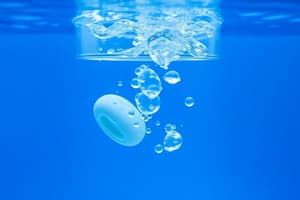Podcast
Questions and Answers
Considering the principles of natural selection, which scenario would LEAST likely lead to the evolution of a new species?
Considering the principles of natural selection, which scenario would LEAST likely lead to the evolution of a new species?
- A population undergoing disruptive selection, favoring extreme phenotypes over intermediate ones.
- A small, isolated population with limited genetic diversity facing a stable environment. (correct)
- A population experiencing frequent mutations and gene flow with other populations.
- A large population with significant genetic diversity experiencing intense environmental pressure.
How does the compartmentalization within eukaryotic cells enhance their functionality, and what would be the most significant consequence if this compartmentalization were absent?
How does the compartmentalization within eukaryotic cells enhance their functionality, and what would be the most significant consequence if this compartmentalization were absent?
- Compartmentalization allows for the efficient distribution of nutrients; without it, cells would starve.
- It facilitates specialized functions in different regions; without it, cellular processes would be less efficient and less regulated. (correct)
- It enables the cell to maintain a stable pH; without it, the cell would become too acidic or alkaline.
- It protects the DNA from damage; without it, mutations would occur more frequently.
In an ecosystem, how would a drastic reduction in the population of decomposers MOST likely affect the nutrient cycle and the overall health of the ecosystem?
In an ecosystem, how would a drastic reduction in the population of decomposers MOST likely affect the nutrient cycle and the overall health of the ecosystem?
- The rate of energy flow would increase due to less energy being lost to decomposition.
- The populations of primary consumers would increase due to reduced competition for plant resources.
- Dead organic matter would accumulate, slowing down nutrient recycling and potentially harming plant growth. (correct)
- Nutrient availability would increase, leading to a boom in producer populations.
Given the principles of Mendelian genetics, if two genes are located very close to each other on the same chromosome, how does this proximity affect their inheritance pattern?
Given the principles of Mendelian genetics, if two genes are located very close to each other on the same chromosome, how does this proximity affect their inheritance pattern?
What is the fundamental difference between a scientific theory and a scientific hypothesis in biology?
What is the fundamental difference between a scientific theory and a scientific hypothesis in biology?
Considering the complexity of metabolic pathways, how might a non-competitive inhibitor affect an enzyme-catalyzed reaction, and what is the primary mechanism behind it?
Considering the complexity of metabolic pathways, how might a non-competitive inhibitor affect an enzyme-catalyzed reaction, and what is the primary mechanism behind it?
How does the principle of homeostasis relate to the survival of an organism in a fluctuating environment, and what is one critical mechanism by which organisms maintain it?
How does the principle of homeostasis relate to the survival of an organism in a fluctuating environment, and what is one critical mechanism by which organisms maintain it?
How would the absence of a cell membrane MOST directly impact a cell's ability to maintain life processes?
How would the absence of a cell membrane MOST directly impact a cell's ability to maintain life processes?
What is the significance of genetic variation within a population, and how does it influence the population's ability to adapt to environmental changes?
What is the significance of genetic variation within a population, and how does it influence the population's ability to adapt to environmental changes?
In the context of ecological interactions, how does the concept of 'trophic cascade' explain the indirect effects of removing a top predator from an ecosystem?
In the context of ecological interactions, how does the concept of 'trophic cascade' explain the indirect effects of removing a top predator from an ecosystem?
Flashcards
What is Biology?
What is Biology?
The scientific study of life, including its structure, function, growth, origin, evolution, distribution, and taxonomy.
Organization (in Biology)
Organization (in Biology)
A characteristic of life referring to the hierarchical structure of living things, from cells to organ systems.
Metabolism
Metabolism
The sum of all chemical reactions within an organism, including energy production and synthesis.
Response to stimuli
Response to stimuli
Signup and view all the flashcards
Homeostasis
Homeostasis
Signup and view all the flashcards
What is a Cell?
What is a Cell?
Signup and view all the flashcards
What is Genetics?
What is Genetics?
Signup and view all the flashcards
Mutations
Mutations
Signup and view all the flashcards
Evolution
Evolution
Signup and view all the flashcards
What is Ecology?
What is Ecology?
Signup and view all the flashcards
Study Notes
- Biology studies life through its structure, function, growth, origin, evolution, distribution, and taxonomy.
- Biology includes botany, zoology, microbiology, genetics, and ecology.
Characteristics of Life
- Living organisms are distinct from non-living matter through organization, metabolism, growth, adaptation, response to stimuli, reproduction, and homeostasis.
- Organization is the hierarchical structuring of living things, from cells to organ systems.
- Metabolism encompasses all chemical reactions in an organism including energy production and molecular synthesis.
- Growth signifies an increase in size and complexity through cell division and differentiation.
- Adaptation allows organisms to evolve traits that improve survival and reproduction in specific environments.
- Response to stimuli is the detection of and reaction to environmental changes like light, temperature, or chemicals.
- Reproduction is the production of new organisms, sexually or asexually.
- Homeostasis is maintaining a stable internal environment despite external changes.
Cell Biology
- The cell, the basic unit of life, executes all life processes.
- The two main cell types are prokaryotic and eukaryotic.
- Prokaryotic cells lack a nucleus and membrane-bound organelles; eukaryotic cells contain these.
- Key cell structures: plasma membrane, cytoplasm, nucleus (in eukaryotes), ribosomes, and organelles like mitochondria, chloroplasts (in plants), and endoplasmic reticulum.
- The plasma membrane regulates substance movement into and out of the cell.
- Cytoplasm is the gel-like substance housing organelles.
- The nucleus contains DNA and controls cell activities.
- Ribosomes synthesize proteins.
- Mitochondria are sites of cellular respiration for energy production.
- Chloroplasts (in plants) facilitate photosynthesis, converting light energy to chemical energy.
- The endoplasmic reticulum synthesizes proteins and lipids.
Genetics
- Genetics is the study of heredity and variation in living organisms.
- Genes, composed of DNA, are the basic units of heredity.
- DNA, a double helix, contains the genetic code.
- The genetic code dictates how DNA information translates into proteins.
- Genes reside on chromosomes within the nucleus.
- During cell division, chromosomes duplicate and pass to daughter cells.
- Mutations, changes in DNA sequence, cause trait variation.
- Inheritance patterns depend on parental gene transmission to offspring.
- Gregor Mendel's pea plant experiments established him as the father of modern genetics.
- Mendel's laws include segregation and independent assortment.
- The law of segregation: each individual has two alleles per trait, separating during gamete formation.
- The law of independent assortment: alleles for different traits are inherited independently.
Evolution
- Evolution is how populations change over time.
- Natural selection, where advantageous traits increase survival and reproduction, drives evolution.
- Charles Darwin's "On the Origin of Species" detailed evolution by natural selection.
- Fossil records, comparative anatomy, embryology, and molecular biology support evolution.
- Fossils document past life forms and their changes.
- Comparative anatomy compares organism structures to reveal evolutionary relationships.
- Embryology studies organism development, showing common ancestry through developmental similarities.
- Molecular biology compares DNA and protein sequences to determine evolutionary relationships.
- Speciation, the rise of new species, often occurs via reproductive isolation and genetic divergence.
Ecology
- Ecology studies interactions between organisms and their environment.
- An ecosystem includes living organisms and non-living components like air, water, and soil.
- Populations are groups of the same species in the same area.
- Communities are groups of different populations in the same area.
- Food chains and webs illustrate energy and nutrient flow in ecosystems.
- Producers, like plants, use photosynthesis to convert sunlight into chemical energy.
- Consumers, like animals, gain energy by consuming other organisms.
- Decomposers, like bacteria and fungi, recycle nutrients from dead organisms.
- Biomes are large ecosystems defined by specific climate and dominant plant communities.
- The biosphere is the sum of all Earth's ecosystems.
- Ecological interactions: competition, predation, mutualism, and parasitism.
- Competition is when two or more organisms need the same limited resource.
- Predation is when a predator kills and eats prey.
- Mutualism is a mutually beneficial relationship between two organisms.
- Parasitism benefits one organism (the parasite) while harming the other (the host).
Studying That Suits You
Use AI to generate personalized quizzes and flashcards to suit your learning preferences.




